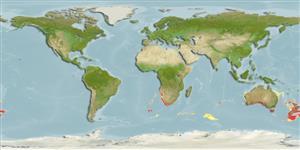Teleostei (teleosts) >
Zeiformes (Dories) >
Cyttidae (Lookdown dories)
Etymology: Cyttus: Greek, kyttaros, kytos = a convex cavity.
Eponymy: William Thomas Locke Travers (1819–1903) was a New Zealand explorer, lawyer, politician and naturalist. [...] (Ref. 128868), visit book page.
Environment: milieu / climate zone / depth range / distribution range
Ecology
Marine; bathydemersal; depth range 200 - 978 m (Ref. 50308). Deep-water; 18°S - 55°S, 5°W - 173°W
Southeast Atlantic: Walvis Ridge and from off Cape Town to Algoa Bay in South Africa. Indo-West Pacific: south coast of Australia and New Zealand.
Length at first maturity / Size / Weight / Age
Maturity: Lm 21.6 range ? - ? cm
Max length : 63.0 cm TL male/unsexed; (Ref. 123586); common length : 33.0 cm TL male/unsexed; (Ref. 9258)
Occurs in offshore waters (Ref. 9258). Juveniles pelagic in surface waters (Ref. 9563).
Life cycle and mating behavior
Maturity | Reproduction | Spawning | Eggs | Fecundity | Larvae
Heemstra, P.C., 1986. Zeidae. p. 435-438. In M.M. Smith and P.C. Heemstra (eds.) Smiths' sea fishes. Springer-Verlag, Berlin. (Ref. 4253)
IUCN Red List Status (Ref. 130435: Version 2024-1)
Threat to humans
Harmless
Human uses
Fisheries: commercial
Tools
Special reports
Download XML
Internet sources
Estimates based on models
Preferred temperature (Ref.
123201): 5.9 - 12.8, mean 8.3 °C (based on 194 cells).
Phylogenetic diversity index (Ref.
82804): PD
50 = 0.7500 [Uniqueness, from 0.5 = low to 2.0 = high].
Bayesian length-weight: a=0.01950 (0.00842 - 0.04514), b=3.01 (2.80 - 3.22), in cm total length, based on LWR estimates for this (Sub)family-body shape (Ref.
93245).
Trophic level (Ref.
69278): 3.9 ±0.87 se; based on food items.
Generation time: 13.7 ( na - na) years. Estimated as median ln(3)/K based on 2
growth studies.
Resilience (Ref.
120179): Very Low, minimum population doubling time more than 14 years (tm=5.2-6.3; Tmax=38; K=0.04-0.07).
Fishing Vulnerability (Ref.
59153): High to very high vulnerability (70 of 100).
Climate Vulnerability (Ref.
125649): High to very high vulnerability (74 of 100).
Nutrients (Ref.
124155): Calcium = 19.5 [10.8, 43.4] mg/100g; Iron = 0.444 [0.162, 0.940] mg/100g; Protein = 17.4 [14.9, 20.2] %; Omega3 = 0.355 [0.181, 0.734] g/100g; Selenium = 20.4 [8.3, 51.5] μg/100g; VitaminA = 12.5 [2.2, 75.2] μg/100g; Zinc = 0.316 [0.203, 0.487] mg/100g (wet weight);
